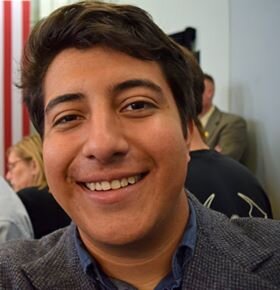Phillip Kimble, Vice President of BHNA serves burgers to residents attending their grant celebration. Santiago Ochoa
Brownell-Holmes residents do the Cupid Shuffle in Logan Park. Santiago Ochoa
Nancy Kimble receives a certificate of appreiciation and a gift card from Sandra Johnson, Project Manager of the Illuminating Communities project.
FLINT, Michigan -- Brownell-Holmes neighborhood residents have benefited from grants written by other parties in the past, but they recently took what they’ve learned from that process to write their own grant to fund a survey of residents' quality of life.
Since its inception, the Brownell-Holmes Neighborhood Association (BHNA) and its members have made themselves an invaluable source of information for organizations looking to invest in Flint’s northside. BHNA’s support has proven essential, as many area residents still harbor resentment and doubt towards outsiders who have not had to face the poverty and decay so many northside neighborhoods have suffered.
This position as a gatekeeper of sorts to the northside has resulted in strong bonds being forged with organizations like the Crim Fitness Foundation, the Ruth Mott Foundation, and Hamilton Community Health Network (HCHN). BHNA’s ability to distinguish itself from the dozens of other block clubs in the area has earned it a seat at the table when it comes to informing these organizations on the community's needs.
One of BHNA’s first large-scale successes came in 2017 when HCHN was awarded a $1 million Community-Based Crime Reduction (CBCR) grant by the U.S. Department of Justice (DOJ) Bureau of Justice Assistance.
For the last three years, HCHN has partnered with community organizations like the North Neighborhood Action Council and BHNA, as well as researchers at Michigan State University, the University of Michigan, and Wayne State University, to survey the community, gather crime statistics, and identify possible crime deterrents.
Sandra Johnson, project manager at HCHN for the Illuminating Community Change Safety Project (commonly referred to as IC2), the program through which the CBCR grant is being implemented, says she’s proud of the work she’s done with the BHNA.
According to Johnson, researchers who were going to survey the community door-to-door got off to a late start in November 2019. The cold winter months put a stop to the surveying and the COVID-19 pandemic arrived before the work could start again this spring.
Not ones to let their voices go unheard, BHNA President Jeanette Edwards and other BHNA members reached out to Johnson with an idea for a grant that would both allow for the research to continue and provide community members with necessities such as school supplies.
The $3,000 grant proposed by BHNA and provided by IC2 through CBCR funding, would be a bit different from previous ones. Though small in value, it was written entirely by members of BHNA. They also oversaw the research needed to prepare the grant.
Johnson says this was a sign of growth for BHNA, as well as one of many examples of the organization going above and beyond. She praises Edwards for her role in the creation and execution of the grant.
“Over the last two years (Edwards) has grown so much and learned so much about the process and instead of always just being seated at the table, she’s now leading discussions and participating,” Johnson said during an event celebrating the success of the grant.
During the months of July and August, residents distributed and filled out "neighborhood life surveys." The surveys asked residents to evaluate their quality of life and to identify safe houses that would be open to children if they encountered trouble while walking or playing in the neighborhood.
At an event in the second week of August, community members were urged to return the completed surveys and enjoy an afternoon of music and food in Logan Park.
“This (grant) is truly resident-driven,” Johnson says. “They’ve been empowered, they’ve been working so hard, and finally this is their opportunity to put their thumbprint on it. I’m really excited about that.”
Ultimately, Johnson says that’s what the CBCR program is all about. More than just providing crime statistics, she wants the data recovered from the program to serve as a form of empowerment for the community, a receipt an organization like BHNA can take to the city to request additional resources.
Logan Park itself provides one example of the power that type of information can bring. The small, privately owned plot of land in Brownell-Holmes serves as a meeting place for many, including the BHNA. Community members including Robert Logan, the owner of the property, believe the city should install public lighting in the area to increase visibility at night and deter crime. Johnson agrees.
“We’re hoping that with a strong enough voice, with enough resident engagement, a block club or neighborhood association like Brownell-Holmes can demand that from the city. They can go in droves, they can go with great numbers, and they’ll have hard data,” Johnson says. “We want them to be empowered to be able to head down to city council, to talk to their councilperson, and demand that there be better lighting and be better attention paid to those types of concerns.”
Johnson says BHNA and its members have raised the bar for what it means to be involved with their community. She is excited to see how much residents are learning and the results their efforts are yielding.
“It’s an amazing thing. They’re learning and getting to better understand that being active and a part of this is what it’s going to take,” Johnson says.
Enjoy this story?
Sign up for free solutions-based reporting in your inbox each week.

Santiago Ochoa is a freelance reporter and communications student at UM-Flint. He is the project editor for On The Ground community reporting series and currently serves as The Michigan Times' Editor-in-Chief. Santiago has worked with publications and organizations like The New York Times, the Interamerican Press Association and Flint Beat. You can reach him @santi8a98 on
Twitter and
Instagram and email him at
[email protected]